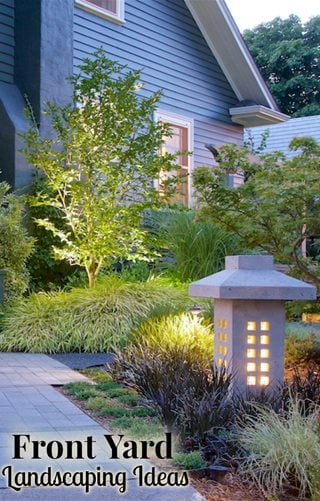Front Yard Landscaping Ideas
Increase the curb appeal of your front garden to provide a warm welcome for guests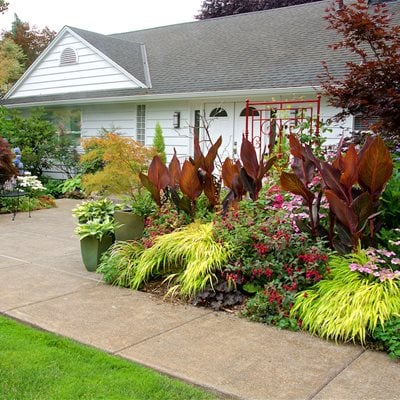
Bill and Charlene Tuttle garden. Photo: Janet Loughrey.
Your front yard is the first thing that neighbors and visitors see, and is your best opportunity to create a first impression. Traditionally, a front yard consisted of a green lawn, a few foundation shrubs, a cement driveway, and sidewalk that leads to the front door. This often-overlooked and underutilized outdoor space presents many opportunities, as well as unique design challenges.
There is no right or wrong way to landscape a front yard. It depends on the look you’re after and how you want to utilize the space. Here are some factors to consider, along with garden ideas to get you started on revitalizing your front yard.
On this page:- PLANNING YOUR FRONT YARD GARDEN
- PLANTING & CARING FOR YOUR FRONT YARD LANDSCAPE
- FRONT YARD DESIGN CONSIDERATIONS
- POPULAR FRONT YARD PROFILES
- FRONT YARD LANDSCAPING IDEAS & INSPIRATION
- FRONT YARD PLANTS
- MORE FRONT YARD IDEAS
PLANNING YOUR FRONT YARD GARDEN
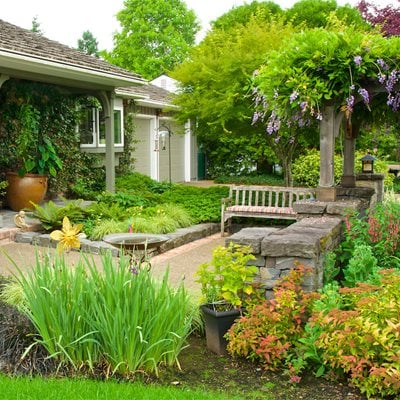
Visitors are greeted by a wisteria-covered arbor that covers part of the walkway from the street to the front porch. An inviting bench offers a place to relax, while a low stone wall provides structure and semi-privacy from the nearby street. Designer: Donna Giguere. Photo: Janet Loughrey.
Evaluate your space. What do you want your front yard to become? A functional area for lounging and playing, or simply a more visually pleasing space? How you choose to landscape your front yard says what you want to convey to others about your home and yard.
If your front yard is visible and accessible from the street, this can create a more welcoming feeling. Conversely, if your front yard is hidden by a tall hedge, fence or wall, this can convey a feeling of seclusion or unwelcomeness.
Privacy barriers. When choosing a living privacy barrier such as a hedge, or an inorganic barrier such as a fence or wall, consider what the function will be. Waist-high hedging or fencing along the front sidewalk will prevent people from wandering into your front yard, yet at the same time allow light and views onto the street.
Fencing might be purely aesthetic, such as an open post-and-beam fence to define a property line, or it might serve a purpose, such as to keep out animals or intruders. If your front yard is adjacent to a busy road, a high privacy barrier may be necessary to block out traffic noise and provide security. Read more about how to landscape for privacy.
Evaluate light. Does your front yard receive full sun, partial sun, or does it have shade trees that create a dense canopy? The amount of light will determine how to use the space and what kind of plants will perform best. Full sun will lend itself to growing warm-season annuals or vegetables, while shade will help keep a seating area cooler in summer.
Consider function. When creating a landscape design, ask yourself what you want your front yard to include. A play space, water feature, or seating area? Don’t be afraid to think outside the box. A front yard can be the site of a vegetable plot, cottage garden, wildflower meadow, rock garden, or patio.
Get ideas. Peruse the internet and walk around your neighborhood for inspiration. Make a list of attributes you like, such as a porch swing, containers, decorative accessories, or types of fencing.
Consider scale. Front yard considerations will be different for a sprawling rural property than a small urban lot. Choose plants that are in scale with the yard. Small plants will get lost in a bigger landscape, while large plants may outgrow a smaller space. Leave enough room for plants to reach their mature size. Provide enough room so seating areas don’t feel cramped, and allow ample space for children to play.
Choose a style. Pick hardscape and plants that will accentuate your home’s facade. A classic picket fence, brick pathway, and clipped boxwood hedging will complement a Colonial home, while a sleek modern fence, aggregate sidewalk, and eclectic plantings will augment a contemporary home.
Draw a design. Make a sketch and formulate a basic plan. For more elaborate projects, consult a landscape professional to create a garden design.
PLANTING AND CARING FOR YOUR FRONT YARD LANDSCAPE
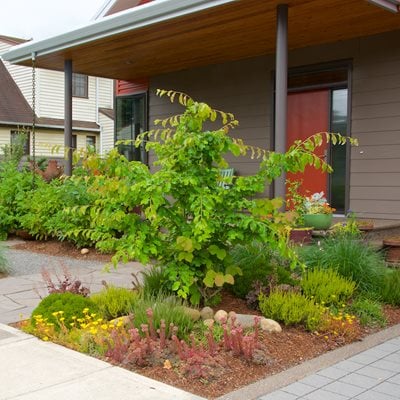
Low-maintenance waterwise shrubs, ornamental grasses, succulents and perennials adorn this front yard landscape. Walkways consist of eco-friendly permeable pavers and gravel, Designer: Marina Wynton. Photo: Janet Loughrey.
Lawn or no lawn? You may want to leave some of the turf lawn for play areas, or to establish green space between garden beds. Since a traditional lawn takes a fair amount of time and resources to maintain, you may decide to ditch the lawn all together and consider alternatives.
For arid climates, a traditional lawn may be impractical or prohibited. Some cities or HOA’s have specific rules when it comes to lawns, so make sure to check your local requirements or restrictions. Read more about eco-friendly alternatives to a turf lawn.
Soil. Determine what kind of soil you have. Many front yards have been solely dedicated to turf lawn, which means the soil is compacted and devoid of nutrients. Amend new planting areas to improve drainage and provide a hospitable growing medium for plants.
Pick the right plants. Choose a mix of trees, shrubs, perennials, vines, annuals, and ground cover plants that will thrive in your site. Consider multi-seasonal attributes such as foliage color, flowers, berries, and bark. Create an engaging foundation planting to soften and set off your home’s facade. Include evergreen shrubs for year-round interest.
Maintenance. How much time do you have to devote to your yard? A low-maintenance xeriscape or native garden is easier to manage than a vegetable plot or traditional lawn. To reduce maintenance, mulch beds to suppress weeds and retain moisture. Choose natives along with other easy-care plants.
DESIGN CONSIDERATIONS
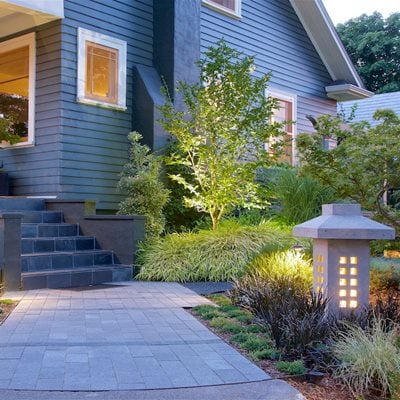
Safety considerations for this engaging front entryway include a spacious staircase and sidewalk, as well as lighting. David Best garden. Designers: Barbara Hilty and Adriana Berry. Photo: Janet Loughrey.
Traffic flow. Evaluate how walkways accommodate foot traffic. A sidewalk that leads from the street to the front door is usually straight. For walkways that lead from the driveway to the front door, or into the back yard, a curved path is more visually pleasing. Follow natural access patterns of children and pets.
Accessibility. Look at various accessibility factors:
- Are your driveway and sidewalks easily accessible from both the street and the house?
- If you have a fence along the front, install a gate that opens easily.
- Is your driveway wide enough to easily move your vehicles?
- Can you exit from your car without stepping on plants or into a puddle?
- Are your walkways wide enough to accommodate two people?
- If your property has a steep slope between the street and the house, add easy-to-navigate steps, a ramp, or jog.
Improve curb appeal. Increase your front yard’s aesthetic appeal. An arbor or trellis planted with a climbing rose creates a welcoming entrance. Use a large container as a focal point. Add color with baskets, a window box, flower beds, a bird bath, or other decorative touches for visual interest.
Create a welcoming entrance. The front door is the centerpiece of your front yard, marking the transition from outdoors to the inside of your home. Some homeowners paint their front door red, which is thought to bring good luck. Others prefer a door that matches the trim or complements the siding on their home. Add adornments such as a doormat, wreath, or containers for extra curb appeal.
Dress up the porch. Depending on the size of your front porch, add comfortable furniture, hanging baskets, and other decorative accessories.
Safety factors. There are many ways to make your front yard safer:
- Make sure stairways are wide enough to comfortably accommodate foot traffic, and that the steps don’t become slick in snow or rain.
- Add landscape lights to illuminate driveways, pathways, and entryways.
- Display your house number prominently to guide visitors or alert emergency responders.
- Don’t allow tall plants to obscure driveway views, home windows, or walkways.
- Provide a mail box that is accessible to your postal carrier but secure from would-be thieves.
- Keep porch steps, sidewalks, and your driveway in good repair to prevent injuries.

POPULAR FRONT YARD PROFILES

Michael Farmdale
A once nondescript front yard in Washington was transformed into a glorious Zen-like, lawn-free garden.
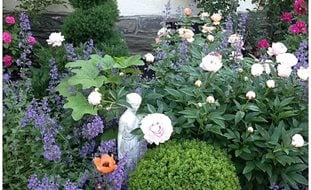
Rachel McGinn and Casey Pradelli
This gardener’s neighbors look forward to spring when her front yard rose garden blooms.
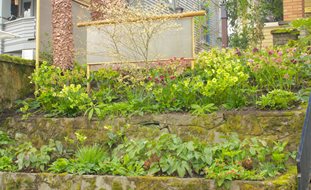
Janet Loughrey
A steep, shady incline didn’t stop this howeowner from creating an easy-care, all-season landscape.
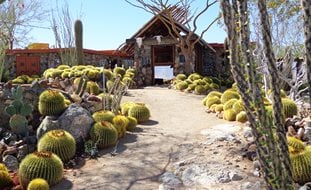
Maureen Gilmer
The unique architecture of this home lends itself to an other-worldly garden with interest all year long.

Joyce A. Hannaford
A neighborhood landmark, this garden also serves as a memories of friends, family, and past homes.
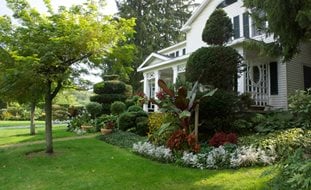
Roger DeMuth
With an eclectic mix of plants, this New York garden has blossomed into a beautiful obsession.
FRONT YARD LANDSCAPING IDEAS & INSPIRATION
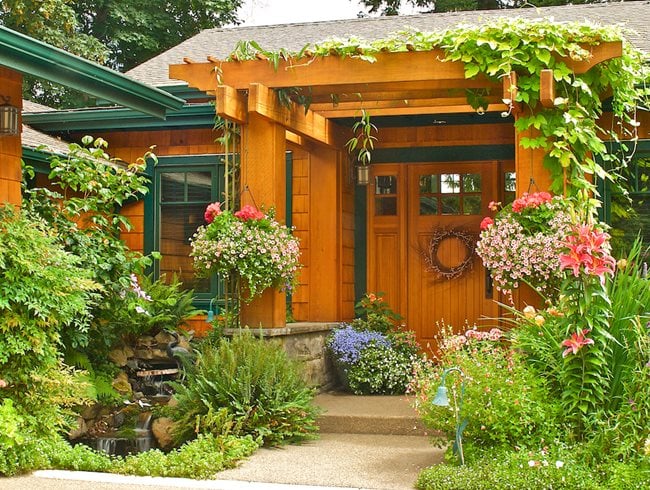
This welcoming front entrance is beautifully adorned with a door wreath, vine-covered arbor, hanging baskets, containers, and perennial plantings. An adjacent water feature provides the soothing sound of moving water. Cheryl Borden garden. Photo: Janet Loughrey.
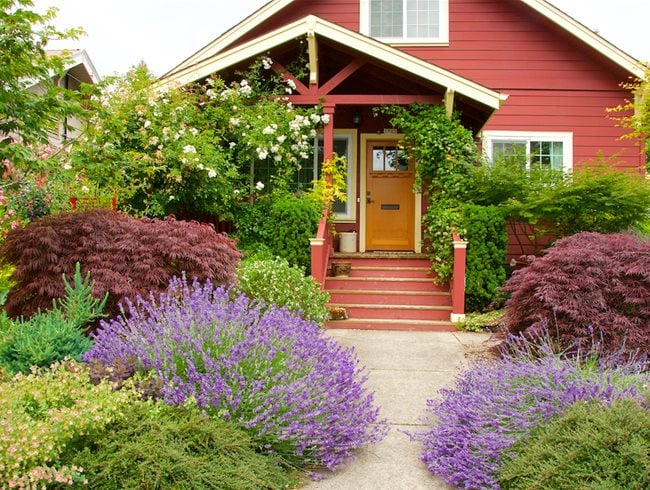
A turf-less front yard landscape consists of climbing roses, perennial vines, Japanese maples, lavender, cotoneaster, evergreens and other plants for a soft layered effect. Jeff and Esther Clark garden. Photo: Janet Loughrey.
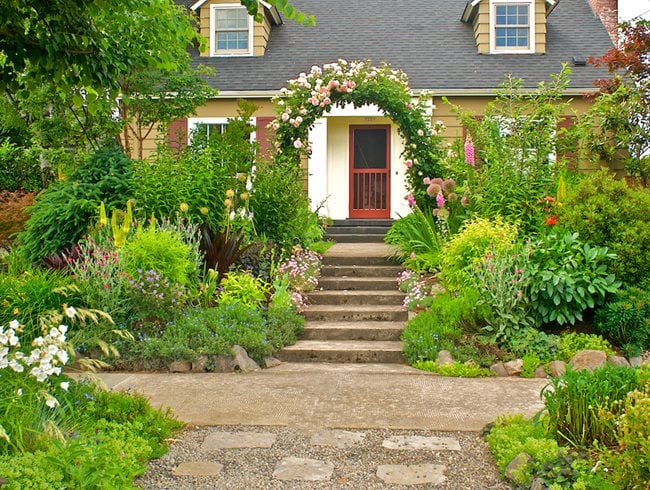
Informal cottage-style plantings along this gentle slope complement the Cape Cod style of the home and provide ever-changing color throughout the growing season. An archway covered with ‘Eden’ climbing rose frames the front door. Mary DeNoyer garden. Photo: Janet Loughrey.
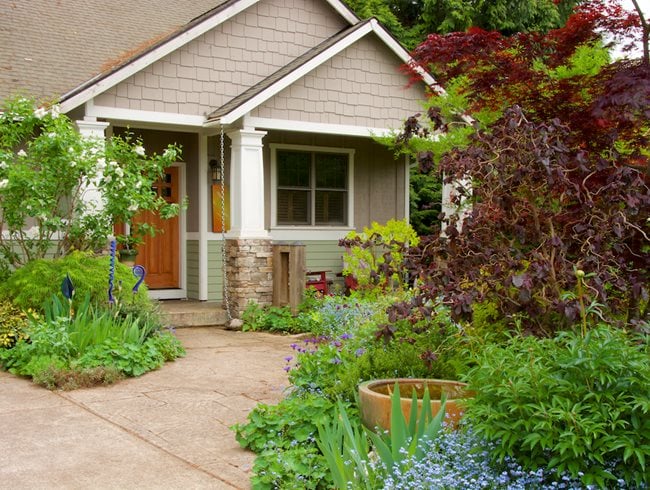
Layered plantings of trees, shrubs, perennials and groundcovers are featured in this grass-less front yard landscape. Burgundy ‘Red Dragon’ contorted filbert provides a living focal point, echoing the foliage color of the taller Japanese maple in the background. Leslie Ebert garden. Photo: Janet Loughrey.
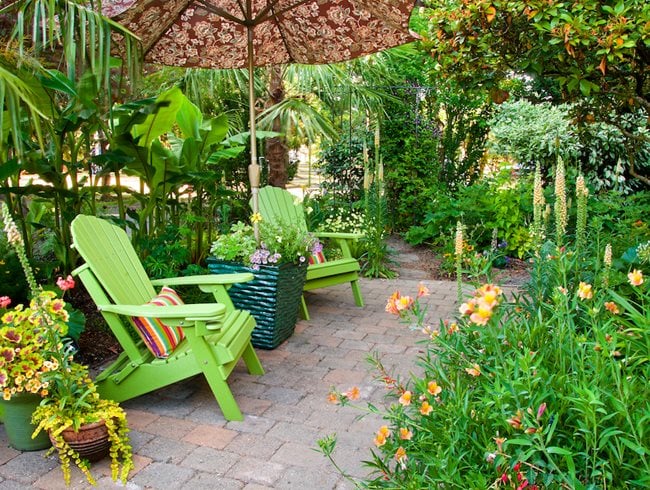
Just a few feet from the street, this private front yard oasis offers a cool haven for relaxation and people watching. Apple-green Adirondack chairs, decorative pillows, a teal container and chartreuse-foliaged plants offer bright pops of color. Jeff Fisher and Ed Cunningham garden. Photo: Janet Loughrey.
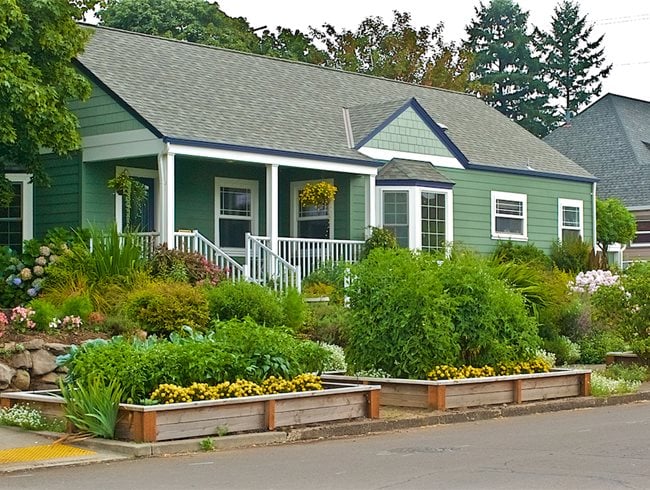
Raised beds along a front curbside strip produce a bounty of fresh vegetables, herbs and strawberries that are shared with neighbors. Jane Mannex garden. Designer: Dave Coennen. Photo: Janet Loughrey.
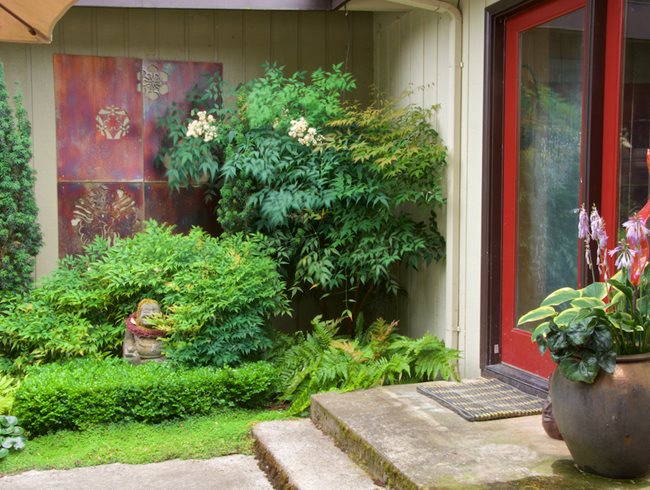
Lush Asian-style plantings, metal wall art and statuary adorn this serene courtyard. The front door is painted red, which is thought to bring good luck. Designer: Vanessa Gardner Nagel. Photo: Janet Loughrey.
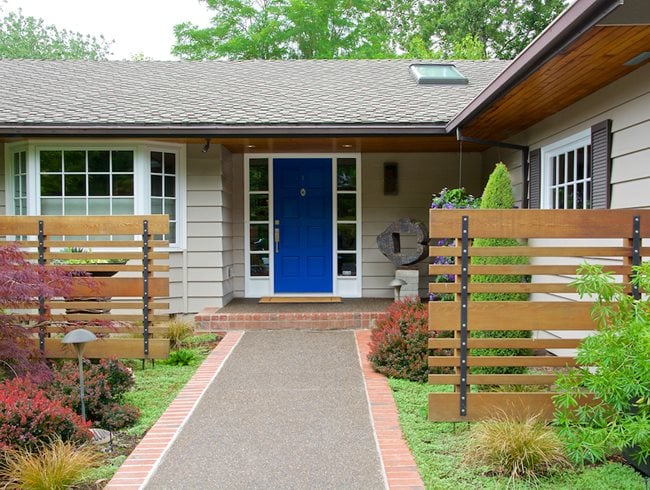
This inviting front entrance features a spacious sidewalk, layered plants in different shapes and foliage colors, and see-through fencing for semi-privacy. Nancy Plumlee garden. Designer: Lori Scott. Photo: Janet Loughrey.
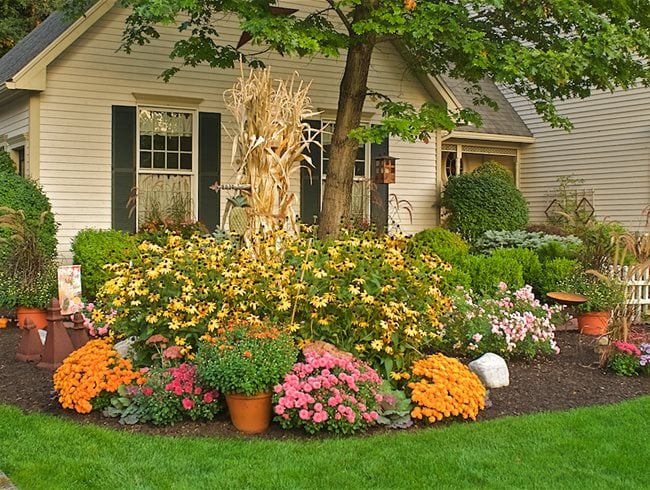
Change the look of a front yard landscape with seasonal decorations and plantings. Rob Saba and Mark Hogan garden. Photo: Janet Loughrey.

Bold foliage of ‘Tropicanna’ canna lily, chartreuse Japanese forest grass, hostas and Japanese maples provide a variety of interesting colors and shapes in this front entryway planting. Bill and Charlene Tuttle garden. Photo: Janet Loughrey.
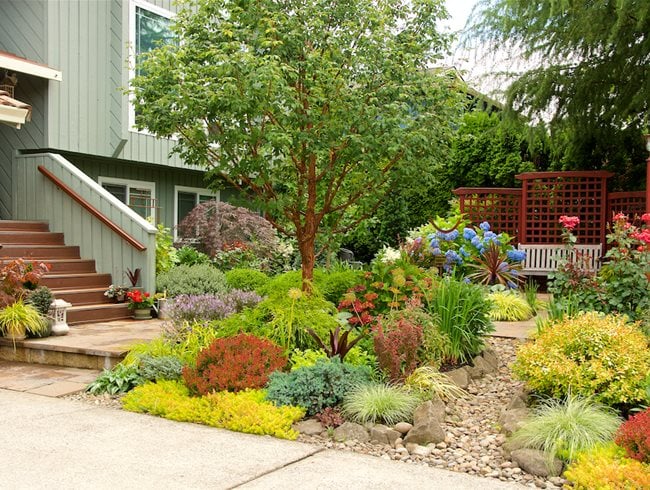
Contrasting gold and red foliage in this front yard landscape create visual drama while providing multi-seasonal color. Echos of brown and burgundy tones in the arbor, tree bark and steps unify the landscape, while different shades of green and blue tone down the brighter colors. Designer: Helena Wagner, 4 Season Gardens. Photo: Janet Loughrey.
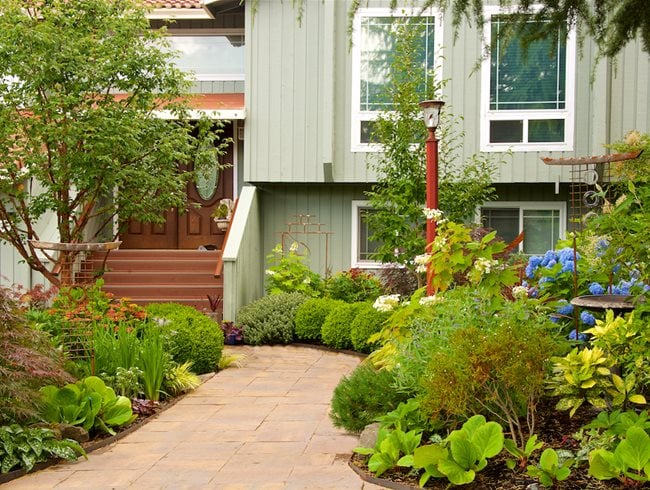
A spacious sidewalk curves just before the stairway to the front door, imploring visitors to explore this engaging front yard landscape. Rounded shapes are repeated in the boxwood shrubs, bergenia leaves and bigleaf hydrangea blooms. Designer: Helena Wagner, 4 Season Gardens. Photo: Janet Loughrey.
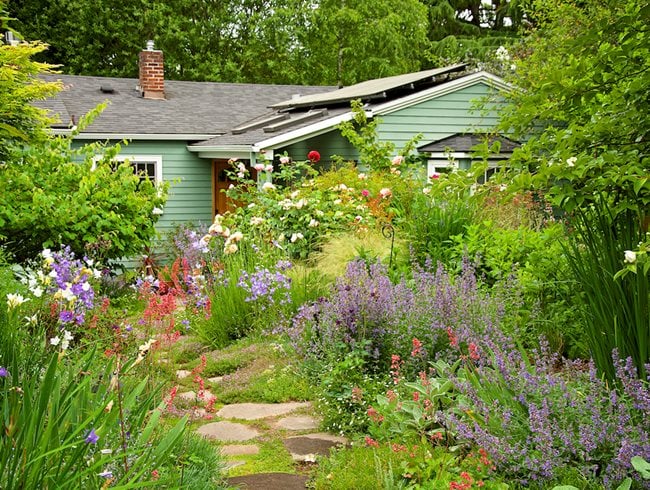
Native and ornamental plants were selected to support beneficial insects and other wildlife in this spacious front yard meadow garden. Jay Withgott and Susan Masta garden. Photo: Janet Loughrey.
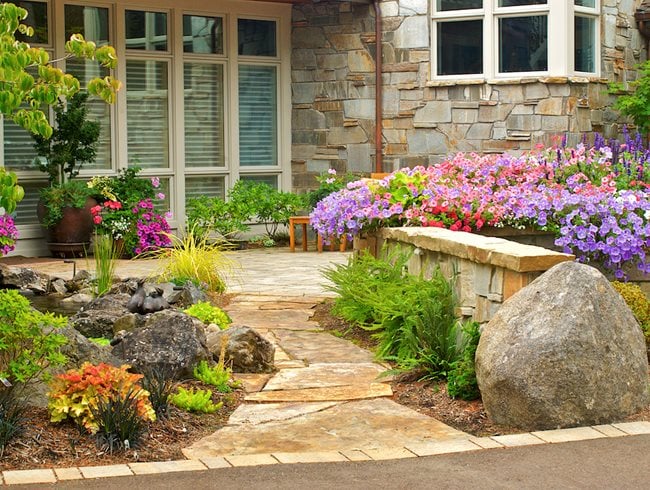
Think outside the box when it comes to front yard landscaping. This entryway includes a rock garden, water feature and lush plantings of brightly colored annuals. Designer: Philip Thornburg, Winterbloom Landscaping. Photo: Janet Loughrey.
FRONT YARD PLANTS

How to use annual flowers and plants to add personality to your garden.

How to use perennial flowers and plants for year-after-year color in your garden.

A guide to growing gorgeous shrubs in your garden.

From maples to magnolias, find the perfect tree for any spot in your garden.

Add year-round beauty to your yard with these ornamental grass varieties.
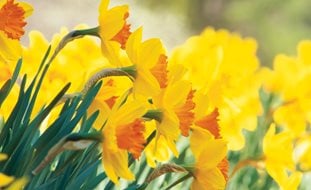
Brighten your garden with fantastic flowering bulbs.
TAKE YOUR FRONT YARD TO THE NEXT LEVEL

Give up your lawn for other more eco-friendly options.

Transform your front yard with foundation planting, lighting, and more. (via LandscapingNetwork.com)

Front yard landscapes designed to reduce maintenance. (via LandscapingNetwork.com)
See how these tips fit into a full outdoor plan—visit our Landscape Design hub for more expert advice.


